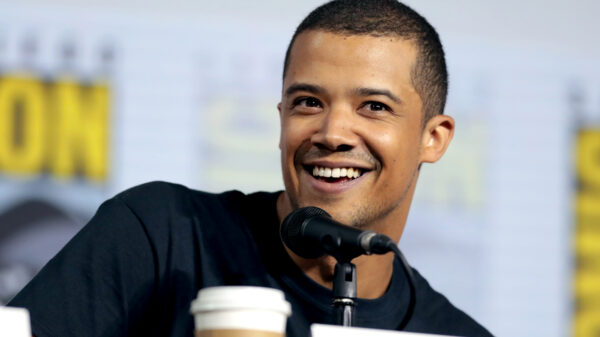Roar writer Saul Levene reviews Daniel Fish’s recreation of “Oklahoma!” at the Young Vic Theatre.
Daniel Fish recreates the classic “Oklahoma!” by Rodgers and Hammerstein in a dazzling, disturbing style. He’s been working on this production for 15 years since his student days at Bard College and has thought hard about where to place the stress and where to cut back.Â
The plywood backdrop littered with decorative guns on the wall convey the mood of the pioneer community. Many scenes feel as if the barn or ancient hall this invokes is at the centre of that community, entailing all the violence and desire for expansion.
Stripped back to only the named characters on set with the orchestra sharing the floor, there’s a tremendous sense of proximity that’s both endearing and, at times, claustrophobic. At the auction, Curly even wakes up in the centre of the orchestra to protest against Jud – a nice touch.Â
This sense of closeness is reinforced by the lighting, bleach-bright at the beginning and feel even brighter when compared to the two total black-out moments later in the play. There are a few stylistic choices like this that make this 1943 musical feel extremely modern. The ballet dream scene, for instance, is stripped back to interpretative dance with a camera following the dancer around the stage.Â

Anoushka Lucas as Laurey Williams. Photography by Marc Brenner
This dancer has the words “Dream, Baby, Dream” on her shirt. The original 1943 production used this dream sequence as a tool to advance the plot, using it to prefigure Laurey choosing Curly. In this version, there’s only the dancing representation of Laurey followed by a camera watching her, with a spectral image of her projected on the wall. I think this leaves the dance scene more beautiful, modern, and mysterious than its original functional purpose.Â
The orchestra is also stripped down to some strings, a banjo and a mandolin, with conductor Daniel Kluger part of the band on accordion, intensely wagging time with his head or a single finger. The score is superb, so fresh and vital that it even makes you wonder why anyone would ever want a bigger band.Â
At the centre of this story are Arthur Darvill’s and Patrick Vaill’s characters, Curly and Jud Fry, that compete for Anoushka Lucas’ Laurey. Darvill plays Curly with a cold, sinister edge, his capacity for violence and jealousy brought to the fore. Curly and Jud butt heads for Laurey, but there’s a connection between them that borders on the homoerotic as, in one scene, they stare at each other nose-distance apart in pitch-black.Â
There is a mad urgency to this revival alongside a willingness to linger on discomfort that is usually brushed over in earlier, prettier productions. Where earlier productions might have glossed over some of the disturbing elements of the murderous Jud Fry, or the frustrations of the spirited farm owner Laurey Williams, this version dwells on them in sharp focus.
Maybe the central theme of this “Oklahoma!” is the desire to forge a new life. The central conflicts come from the inability to do that successfully. Each of the main characters want to explore life in a new way and to feel and own new things in a changing world. There is parallelism between Jud and Laurey as they both speak about their desires in life, about owning things and being respected. This could have been passed off as ridiculous; and of course Laurey would never really get with Jud. But this production doesn’t do that – there’s a real, if sad and disturbing, similarity between their characters.
Characters are given greater depth as Marisha Wallace, for example, brings Ado Annie from a comic character on the sidelines to a character brimming with energy and exploring thwarted desire as she holds two men by a leash.

Patrick Vaill as Jud Fry. Photography by Marc Brenner
Jud Fry’s character is also elevated from a villain to a misunderstood “incel”, stewing in his own rage and loneliness. In this rendition, we feel genuine sympathy for him. Curly provoking Jud by saying that the only way people would care about him is if he was dead isn’t playful and boyish. It borders on the tragic. From bullying to mental illness, there’s a good argument made here for a sympathetic look at Jud. Vaill has been developing this character since the start of this production in Bard College and, by God, it shows.
The largest change from the original was perhaps the reframing of the ending that takes a turn to the Kafkaesque. When it does come to a close, there’s a sense that not everything has been sorted out. Curly and Laurey’s costumes are dirty and people still have unresolved desire that the musical just doesn’t address. Finishing on the big “Oklahoma – OK” number feels more disingenuous than satisfying, and maybe that was intended, maybe not.
It’s not a perfect production but it is intensely enjoyable. Its revival has been done remarkably well and the superb acting provides a fantastic new perspective on this classic. Sometimes it’s difficult to remember but “Oklahoma!” was one of the first “modern” musicals after “Show Boat”; one of the first shows to have a storyline connecting all the songs like an opera. For 80 years on the clock, it feels like it was written yesterday.Â
















